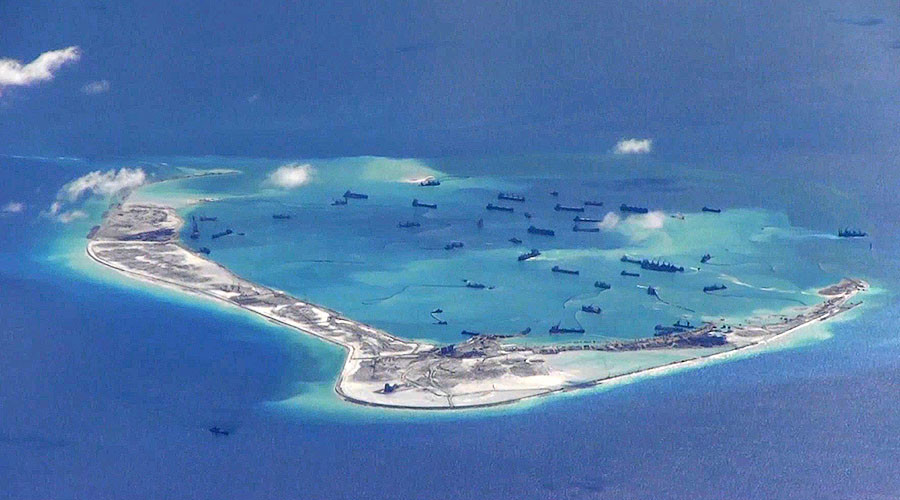Sino-Russian South China Sea energy partnership
March 28, 2019 | Expert Insights

Russia and China to explore the viability of gas hydrates, a potential energy market disrupter, in the contentious South China Sea.
Background
Clathrate hydrates or gas hydrates are water-based crystalline solids in which a host water molecule traps a guest molecule that is typically a gas or liquid, often hydrocarbons. First documented in 1810 by Sir Humphry Davy, gas hydrates occur naturally in large quantities, especially the ocean floor. Although analysts view gas hydrates as an enormous energy resource with some estimates claiming twice the amount of all fossil fuels on earth, engineers are yet to provide an economically feasible method of extraction. Gas hydrates are not an unfamiliar quantity among oil industry experts, given that they form as obstructions inside gas pipelines. In 2017, Japan and China announced that they had separately attempted the extraction of methane hydrates from the ocean floor. Although some of these attempts were successful, commercial production remains elusive.
Official relations between China and Russia were initiated by border clashes in the 17th Century. Since then, both countries have undergone significant ideological, political and economic upheaval. In recent years, in an effort to offset America’s geopolitical reach, China and Russia have sought to forge closer ties. Both countries seek to position themselves as peer competitors to the United States, with Russia becoming China’s biggest and most secure supplier of crude oil. In 2018, China-Russian trade had reached the US $107 billion dollars, with Russia ranking first among China’s 10 largest trade partners in terms of turnover growth. 2019 marks the 70th anniversary of the establishment of diplomatic ties.
Chinese leader Xi Jinping and Russian leader Vladimir Putin have met repeatedly in the recent past and have often aligned on multiple issues in world affairs. As authoritarian leaders, Mr. Xi and Mr. Putin share a number of similarities.
Analysis
In July 2019, Russian scientists will join their Chinese counterparts to explore gas hydrate deposits on the seafloor of the South China Sea. The President of the Russian Academy of Sciences, Aleksandr Sergeyev said, “The Chinese side is looking for methane emissions (in the South China Sea) and links them to the presence of (gas) reserves. They invited us to take part in the expedition dedicated to exploration of gas hydrates, which begins approximately in July.”
China’s position as one of the world’s largest energy consumers, while lacking significant natural gas reserves of its own, pushes the nation towards securing its energy future. Currently, China imports a large amount for its energy requirements and securing its energy needs is paramount to China’s geo-strategic goals.
The South China Sea is estimated to hold immense natural gas reserves and also provides China with a unique strategic advantage should it establish its supremacy over the region. Currently, the South China Sea is contested by China, Vietnam, the Philippines, Taiwan, Malaysia and Brunei. While most analysis centred around the region is focused on its position as a major shipping route and on freedom of navigation operations, China’s desire to hold the region unopposed is also guided by its need for energy. The United States is cognizant of China’s need for energy and its intention to procure it from the South China Sea and will seek to boost the claims of other parties in the region. China in-turn will look to develop partners in the region in order to secure a feasible outcome that meets her strategic needs.
The relationship between Russia and China is ripe for the taking. President Xi and President Putin find commonality over the quest to diminish American hegemony and the South China Sea provides both leaders with a tremendous opportunity. Together they pose a formidable military and engineering force; in the extraction of gas hydrates, their combined technological prowess may prove decisive in delivering a feasible extraction solution. Russia’s position as China’s largest crude oil supplier, alongside Russia’s involvement in a project that may serve as a potent market disrupter is of tremendous strategic value to both parties. Should the technology prove viable, its implementation could begin across the world, with Chinese and Russian companies maintaining the technological and economic edge. However, given the US will attempt to develop its own technology, it will be a race of innovation, efficiency and time.
Assessment
Our assessment is that while gas hydrates could serve as an enormous market disrupter in the energy sector, it does not address environmental concerns. We believe that China and Russia will actively participate in a project that, if successful, could provide a strategic advantage. We feel that China’s activity is also aimed at further entrenching itself in the South China Sea by legitimising its presence with a third party such as Russia that remains conducive to her ends.








Comments